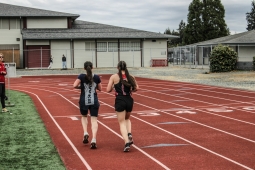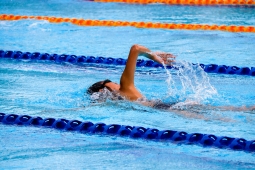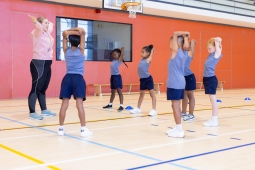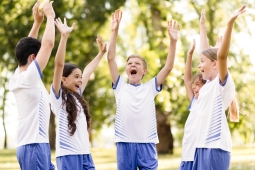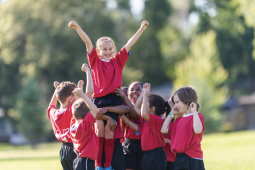Problematizing and Rethinking Elementary Track and Field School Days: Re-envisioning a Future for All

Abstract
Elementary track and field days can be an enjoyable way of participating in physical activity outdoors. Unfortunately, these events are not always a positive experience for all students, and they may even have the opposite effect we are striving for with regard to developing a physical activity foundation for life. Intrigued by our experiences and observations in our embodied fields of physical and drama education, this article raises awareness and problematizes the elementary track and field day events. In particular, we trouble existing practices regarding able-bodiedness and the gender binary. We conclude with thoughts around exciting possibilities for what a school day of physical activity participation could look like, celebrating the multitude of talent and skills that exist in every school across the country.
Introduction: Encounters with Track and Field Days
We preface this paper by positioning ourselves and explaining how we came to this inquiry about track and field days. We are two white, cisgender, temporarily able-bodied women who work as professors in embodied fields in education: physical education (PE) and drama. Our experiences with track and field days in our childhood were quite different.
Alexandra: PE was one of my favourite subjects, and I was fortunate to have a parent who advocated for the subject when my teachers were having double math periods in place of our infrequent PE periods. Outside of school, I spent the majority of my extracurricular time in competitive dance. With my parents’ encouragement and support, I also tried out for various school teams experiencing a mixture of success and rejection (i.e., being de-selected/cut at tryouts). I was excited about the possibility of earning track and field ribbons and was fortunate to do well. I enjoyed these elementary school track and field day events because it was an opportunity to be outside and physically active.
Sara: From what I remember, my elementary school in Quebec did not have formal track and field days. There was an annual sports day held at a park, with informal events and ribbons. My first encounter with formalized track and field came when I moved to the West Coast and learned that sports are a serious business there. By then, I had gone through puberty and was considered overweight. Track and field meant wearing shorts, having my body on display in ways that made me uncomfortable, and risking public humiliation if I finished last. Although I loved physical activity, I distanced myself from track and field and PE because it amplified my insecurities. Instead, I hung out with the “artsy kids.”
Recently, we have had experiences with elementary school track and field days that led us to ask questions about the purpose of these events and their impact on the children for whom they are organized. In addition to our roles as professors, we are also a substitute teacher (Alexandra) and a parent (Sara) who have been puzzled by some of the practices that we have encountered (e.g., forcing children to participate, excluding children who are injured, telling students who don’t participate that they have to stay home or with classes in a lower grade, binary gender—girl or boy —events, clothing mandates). While our initial conversations were informal, these issues continued to weigh on us, especially as we reflected on how they connect with the embodied subjects we teach. Our disciplines are often divided by the popular misconception that artists are not athletic and athletes are not artistic, as frequently portrayed in television shows like Glee!. This false yet pervasive myth is further fueled by the disproportionate funding that athletics receive at many schools and the higher social status attributed to participating in sports rather than in the arts (Goodwin, 2020). We write together because this artificial divide impacts the ways that people perceive themselves, their bodies, and the possibilities of what they can achieve. We are invested in making PE and drama more welcoming and accessible for all learners. For this reason, we have continued to discuss the structure of elementary track and field days and problematize how they are implemented.
Our analysis of track and field days is informed by standpoint theories (e.g., feminism, hooks, 2015) critical race theory (Delgado & Stefancic, 2013, Ladson-Billings & Tate, 1995), disability studies (Kuppers, 2022); and queer theory (Potvin, 2020), as they enable us to consider how social practices, like schooling, impact individuals differently based on their identities, identifications, and presentations. While they differ in some of their philosophical orientations, these theories shed light on the ways that power operates within social institutions to privilege some, while disadvantaging others. These theories also gave rise to intersectional analyses that account for the ways that multiple forms of marginalization, when experienced simultaneously, compound the effects of domination on certain people (Collins & Bilge, 2016; Crenshaw, 1990; Davis, 1983). Here, we lay out some issues with school track and field days, explore why they can be problematic for some children, and offer suggestions for how to reimagine these days for diverse student populations.
Physical Education, Physical Literacy, and Track and Field
In this paper, we define elementary track and field days as a singular day devoted to track and field events where it is compulsory for students (often Grades 5-8, sometimes Grade 4) to participate. The compulsory form may look different from school to school (e.g., participating in at least three events, rather than all events). It is important to differentiate elementary school track and field days from other related events, like extracurricular track and field meets or play days/carnivals (i.e., alternative examples of whole school participation). Track and field itself could be perceived as inclusive due to its flexibility and variety of running, jumping, and throwing events. Track and field days typically engage most school staff, a PE teacher responsible for organizing, students from Grades 5-8, and lots of coordination and planning. Contingency plans are made well in advance, in case of inclement weather. Common events include sprints, long run, relays, high jump, long jump, and shot put/ball throw. Interestingly, track and field days seem to be one of the few days in the school year where students in selected grades are required to participate (coerced participation rather than willing participation) in physical activity.
Literature about track and field tends to revolve around the teaching of track and field in PE (Werner & Almond, 1989) or track and field as sport (e.g., competition); there is limited information on the school track and field day event. One of the earliest articles we found related to the idea of the track and field day was a description of a program from 1945 (Miller et al., 1945). This program noted that the intent of the field day – described as “a day with special emphasis on track events, plus a varied program of folk dancing, playground games, mass calisthenics, and marching” (p. 315) – was for students to display the skills they had learned in PE throughout the year. It should be highlighted that despite the purpose being an opportunity to evaluate students’ acquisition of skills through PE, there was a focus on gendered teams, winning (i.e., points given to winning teams and first through third finishers in each event), and citizenship (Miller et al., 1945). A specific example noted that “an elimination contest for each event was held as a part of the regular class work” (Miller et al., 1945, p. 360) during skill practice in PE. Track and field days are founded on principles of competition that reify the outdated, disproven, and harmful ideology of “survival of the fittest” (Duncan & Kern, 2020, p. 37). By celebrating top place finishers, the meritocratic notion that “fair competition” is absent of discrimination and results in clear winners and losers is explicitly reinforced through these school practices. This approach lies in opposition to the quality PE that we expect to find in Canadian schools today. As Duncan and Kern (2020) note, not all competition is bad, “however, competition may be inappropriate when it is overused, conducted without regard for individual preferences or developmental needs, or viewed within a narrow context of either winning or losing” (p. 34). Werner and Almond (1989) identify an issue at the heart of traditional track and field days:
...emphasis on winning does not provide all students with an appropriate medium for monitoring their progress or achieving satisfaction in their performance. A person who places in the middle or last in a running, throwing or jumping event will take little comfort from the fact that [they have] improved unless personal achievement is the focus. Repeating a competitive experience is hardly likely to enhance satisfaction and encourage further participation if the student recognizes only that winning is impossible. (p. 66)
Greater emphasis on personal achievements could help rectify this issue; however, rethinking the messages underlying this approach to sport might offer a better remedy.
Today, PE is about much more than athletes and physical fitness. As defined by United Nations Educational, Scientific and Cultural Organization (UNESCO):
Quality Physical Education (QPE) is the planned, progressive, inclusive learning experience that forms part of the curriculum in early years, primary and secondary education...QPE acts as the foundation for a lifelong engagement in physical activity and sport. The learning experience offered to children and young people through [PE] lessons should be developmentally appropriate to help them acquire the psychomotor skills, cognitive understanding, and social and emotional skills they need to lead a physically active life. (Adapted from the 2008 Association for Physical Education Health Position Paper by McLennan & Thompson, 2015, p. 9).
In recent years, physical literacy has been identified as the underlying goal of PE (Whitehead, 2010), and UNESCO recognizes that the outcome of QPE is “a physically literate young person, who has the skills, confidence, and understanding to continue participation in physical activity throughout their life-course” (McLennan & Thompson, 2015, p. 20). PE should be developing physical literacy, and part of that includes motivating children to engage in physical activity. That said, if PE and physical activity opportunities produce negative experiences, they could have the opposite effect (e.g., negative PE memories have been associated with sedentary behaviour in adulthood; see Ladwig et al., 2018). In their scoping review, Lee and colleagues (2025) conclude that multiple barriers to physical activity exist for adults from equity denied groups in Canada. They add that these extend from the individual level to exo- and macrosystem levels and include, but are not limited to, racism, colonialism, xenophobia, homo- and transphobic cultures in sports, ableism and discrimination based on body size. Their findings extend Sykes’ (2011) work on the ways that gender and sexually diverse youth cope with homophobia, transphobia, and fat phobia in schools.
While there are certainly positives to the track and field experience (e.g., increased physical activity, being outdoors, supporting and celebrating peers), there are also negatives that are ingrained within the organization and structure of how these days operate. If the intent is to be inclusive and to create a foundation that motivates students to be physically active throughout their lifespan, do track and field days meet this obligation? Moreover, do these days fulfill this commitment for every student? Alternatively, is the unstated goal of track and field days to focus on the elite few students who will go on to compete at the school division/district wide track meets? We wonder: What is the intent of school track and field days?
Troubling Existing Practice
Track and field days are implemented in ways consistent with wider social practices of constructing some bodies as "normal,” while failing to anticipate bodies that do not conform with this ideal. Researchers and disability activists have long identified limited understandings of normalcy as a social construction that is invested in white supremacist and cis-heteronormative patriarchal values that work to marginalize and exclude (Kuppers, 2022; Watkin & Degrow, 2022). We understand white supremacy as a socio-political and historical process through which a system of domination was created that imposed idealized white, able, and cis male bodies as the pinnacle of humanity (Leonardo, 2004). Research has shown that the bodies anticipated by schools are ones that conform with whiteness, cis male and cis female categories, and “able” bodies (skelton, 2022).
Specifically, PE has a problematic history as a school subject because there are “...a narrow range of bodies idealized by [PE] as motor skilled, able-bodied and healthy and socially idealized through whiteness, muscularity, thinness, heterosexuality and coherent gender” (Sykes, 2011, p. 101). This is consistent with our observations of track and field days that are inadequately prepared for students with permanent or temporary disabilities, children who fall outside the gender binary, students who do not wear shorts and t-shirts for religious reasons, and children who simply do not want to participate in the competitive environments created. Our observations and the anecdotal accounts we have heard from parents and teachers suggest that some children feign illness, injury, or ask to miss track and field days because they are uncomfortable or dislike competition. Avoidance and absenteeism can be strategies of resistance against overly prescriptive or rigid school practices (Jones, 2019). The compulsory nature of track and field days is thus problematic as it forces students to participate in practices that make them uncomfortable or that may be harmful to their sense of self. While there are many aspects of the track and field day that we could discuss, and we are aware of the significant ways that race and racialization play out in sport and PE (see for example Blackshear & Culp, 2023; James, 2005; Hall, 1997) and the significant ways that intersecting categories of identifiers further impact the experiences of children in schools, to limit the scope of this paper the following sections focus on disability and the gender binary.
Able/bodied. The binary relationship set-up between “disabled” and “abled” bodies is a fiction that conceals the many ways that all bodies are capable of doing many things, while simultaneously having limitations that prevent them from carrying out certain tasks in particular ways. At best, being able-bodied is a temporary condition experienced by those whose bodies conform to constructed norms. Kafer (2013) explains that disability studies and movements sometimes draw attention to this fact by describing temporarily able-bodied people by using the acronym “TAB.” Rather than exclude students with disabilities from fully participating in track and field days, or limiting their participation to roles like time keeper or sand raker, it would be best to provide students with authentic, meaningful modes of participation. Harvey (2016) notes that it is critical for people with disabilities to determine their own PE or physical activity opportunities based on a bottom-up approach, i.e., decisions made with them rather than for them. Recent Canadian research similarly indicates that students with disabilities are historically excluded from school sport and that there are inequitable opportunities for students with disabilities to engage in physical activity opportunities (Robinson et al., 2025). Clearly more can be done to better adapt to the needs of all students.
Disability studies and movements propose rethinking our relationship to time, movement, and access in ways that trouble taken-for-granted norms that are the root of social exclusion (Kafer, 2013; Kuppers, 2022). For track and field days, this might include valuing slow or stationary movement by allowing participants to move in ways that are possible and creative for them. Such movement should also be valued and rewarded, as are first, second, and third placed finishers of a race. Encouraging participants to move creatively to the sounds of birds or wind could be an activity that engages students with their outdoor surroundings, as well as inviting them to be attuned to their bodies and movement potential. Such activities require a radical re-thinking of the activities put on by schools.
Binary gender. Track and field days at elementary schools often force students to adhere to a rigid, assumed girl: boy gender binary. Some attempts at expanding gender categories have resulted in the creation of “girls and nonbinary” categories that do not adequately address how gender creative children identify. Furthermore, such categories raise serious questions about why nonbinary children are asked to compete alongside cis girls rather than with cis boys. To prioritize equity and social justice, Sykes and Smith (2016) note that we need to “name the histories and systems of gender oppression” (p. 271). skelton (2022) provides clear directions for what schools could be doing:
...instead of relying on children to challenge their discriminatory gender practices, schools could adopt an affirming model of care and do the work to anticipate [Gender Independent, and Nonbinary, Trans] children and build safety for them. This is work that all schools need to be doing. Believing in children, and in children’s understandings of who they are, should be central to learning and education. (p. 270)
In recent years we have witnessed an explosion in the policing of the bodies of people participating in track and field events from the elementary school level to the Olympic games (Morrison, 2024; Szeto & Strachan, 2023). While it is important to note that most of this policing (i.e., transvestigating; Egale Canada, 2024) has occurred at competitive track meets, it is not a leap to anticipate this happening at school track and field days in the current political climate. This concerns us because it discriminates against some of the most vulnerable people in our society: trans, nonbinary, gender creative, queer, Indigenous, Black, and people of colour. Gender policing threatens the safety of people perceived as not conforming with expected norms, undermines their rights, and denies their humanity. Second, policing gender categories draws away from creating environments where all students are encouraged and supported in their decisions to participate in physical activities. Research indicates that trans, nonbinary, gender creative, and queer people may avoid sporting events where gender binaries are reinforced (Carter & Baliko, 2017; Gumprich et al., 2024).
Imagining Future Possibilities
We understand the complexities of working and being in schools. When we talk about reimagining track and field days, we think about ways that participation can be broadly rethought to provide opportunities for all children to be active, try new forms of movement, and have fun while having all of their humanity recognized. This does not necessarily mean doing away with all competitive events. It may, however, entail facilitating traditional events alongside creative, cooperative, and playful ones. We imagine ways that our disciplines, inclusive of sport and performance art, might come together to celebrate the multitude of talents and skills that exist in every school across the country. We are encouraged by schools and districts that have already started combining sporting and cultural activities during annual track and field days.
One size does not fit all, and each school will require unique solutions to respond to the needs of their students, staff, and local contexts. The most significant way that track and field days could be changed is by asking kids how they would like to see these days reimagined. It would be especially important to involve all students in the process so that those who feel excluded by track and field days get to express their opinions. This could be done by consultation with children through an in-class activity, done across all grades, at the beginning of the school year. Since teachers usually use the first weeks of class to build relationships, this would be an ideal time to ask kids what kinds of activities they do and do not like and what a reimagined track and field day might look like. Children could be invited to share their ideas through writing/signing, drawing, photography, singing, drama, dance, etc. A follow-up invitation could be sent to parents/guardians to seek input from their children that they could share with the school, outlining some of the historical challenges and the school’s desire to change existing practices and ensure that they are meeting the needs of the school community. Student committees could help organize the days and provide more options. Including local disability justice activists in the planning could also strengthen the activities and approaches adopted for each school community. In making these suggestions, we have been inspired by participatory action research projects inviting children to co-design sporting activities and reimagine school spaces to suit their bodies (Robinson et al., 2025; skelton, 2022). We want children to love movement. The ways we design movement opportunities are key for ensuring that it is joyful and allows children to love their bodies. By re-envisioning elementary school track and field days, new possibilities for participation may emerge that enable students to create the world they want to live, play, and move in.
References
- Blackshear, T., & Culp, B. (2023). Critical race studies in physical education. Human Kinetics.
- Carter, C., & Baliko, K. (2017). ‘These are not my people’: Queer sport spaces and the complexities of community. Leisure Studies, 36(5), 696-707.
- Collins, P. H., & Bilge, S. (2020). Intersectionality. John Wiley & Sons.
- Crenshaw, K. (1990). Mapping the margins: Intersectionality, identity politics, and violence against women of color. Stanford Law Review, 43, 1241.
- Davis, A. Y. (1983). Women, race & class. Knopf Doubleday Publishing Group.
- Delgado, R., & Stefancic, J. (Eds.). (2013). Critical race theory: The cutting edge (3rd ed.). Temple University Press.
- Duncan, C.A., & Kern, B. (2020). Getting competition under control. Journal of Physical Education, Recreation & Dance, 91(2), 33-41. 10.1080/07303084.2019.1693451
- Egale Canada. (2024). Egale explains: “Transvestigation” in sport and how it feeds misogyny. Egale. https://egale.ca/awareness/egale-explains-transvestigation/
- Goodwin, T. (2020). Extracurricular programming: The need for more diverse activities [Poster presentation]. Academic Festival Sacred Heart University, Fairfield, CT. https://digitalcommons.sacredheart.edu/acadfest/2021/all/141/
- Gumprich, M., Watt, S., Black, S., Jeyabalan, T., Delgado-Ron, J., & Salway, T. (2024). Nonbinary youth and young adult experiences in organized team sports in Canada. International Journal of LGBTQ+ Youth Studies, 1–20. https://doi.org/10.1080/29968992.2024.2421208
- Hall, S. (1997). The spectacle of the other. Representation: Cultural representations and signifying practices, 7, 223-290.
- Harvey, W. (2016). Looking over our shoulders: Disability in physical education from a critical perspective. In D. B. Robinson & L. Randall (Eds.), Social justice in physical education: Critical Reflections and pedagogies for change (pp. 122-137). Canadian Scholars’ Press. hooks, b. (2015). Ain’t I a woman: Black women and feminism (2nd ed.). Routledge.
- James, C.E. (2005). Race in play: Understanding the socio-cultural worlds of student athletes. Canadian Scholars’ Press.
- Jones, C.A. (2019). “No-one likes what I say”: A Foucauldian discourse analysis of problematic absenteeism from school [Doctoral dissertation, Cardiff University].
- Kafer, A. (2013). Feminist, queer, crip. Indiana University Press.
- Kuppers, P. (2022). Eco Soma: Pain and joy in speculative performance encounters. University of Minnesota Press. https://manifold.umn.edu/read/eco-soma/section/20b46408-f95a-4e54-85b1-0028122ae18d#cvi
- Ladson-Billings, G., & Tate, W. F. (1995). Toward a critical race theory of education. Teachers college record, 97(1), 47-68.
- Ladwig, M.A., Vazou, S., & Ekkekakis, P. (2018). “My best memory is when I was done with it”: PE Memories are associated with adult sedentary behaviour. Translational Journal of the ACSM, 3(16), 119-129. 10.1249/TJX.0000000000000067
- Lee, E. Y., Alamshahi, Y., Cheng, J., Vanderloo, L. M., Faulkner, G., Ferguson, L., & Spence, J. C. (2025). A scoping review of barriers and facilitators of physical activity among equity-denied groups in Canada: An intersectional equity lens. Journal of Immigrant and Minority Health, 1-17.
- Leonardo, Z. (2004). The color of supremacy: Beyond the discourse of ‘white privilege’. Educational philosophy and theory, 36(2), 137-152.
- McLennan, N., & Thompson, J. (2015). Quality physical education (QPE): Guidelines for policy-makers. https://unesdoc.unesco.org/ark:/48223/pf0000231101
- Miller, J. M., Bermingham, M. C., Ingersoll, V., & McGoldrick, M. (1945). A track and field program for the elementary school. The Journal of Health and Physical Education, 16(6), 315–361. https://doi.org/10.1080/23267240.1945.10626020
- Morrison, T. (2024, August 2). FACT CHECK: Olympic boxer Imane Khelif, participation and eligibility in the Paris 2024 Olympic Games. GLAAD. https://glaad.org/fact-check-participation-and-eligibility-of-paris-2024-olympic-boxers-imane-khelif-and-lin-yu-ting/
- Potvin, L. (2020). Queer pedagogies. In N.A. Naples (Eds.), Companion to Sexuality Studies (pp. 122-139). John Wiley and Sons.
- Robinson, D.B., Barrett, J., Walters, W., & Harenberg, S. (2025). Game Changers: School sport as a resource of hope for students with disabilities. Pedagogies: An International Journal, 20(1), 32-53. 10.1080/1554480X.2024.2397531
- skelton, j.w. (2022). Schools often fail to expect trans and nonbinary elementary children: What Gender Independent, Nonbinary, and Trans children desire. Teachers College Record: The Voice of Scholarship, 124(8), 244-274. 10.1177/01614681221126243
- Sykes, H. (2011). Phantasy, imaginary and anxiety. In H. Sykes (Eds.), Queer bodies: Sexualities, genders, & fatness in physical education (pp. 88-104). Peter Lang.
- Sykes, H., & Smith, C. (2016). Trans*, intersex, and cisgender issues in physical education and sport. In D. B. Robinson & L. Randall (Eds.), Social justice in physical education: Critical Reflections and pedagogies for change (pp. 271-296). Canadian Scholars’ Press.
- Szeto, W., & Strachan, B. (2023, June 14). 9-year-old's gender questioned in 'gobsmacking' track-and-field incident, family says. CBC News. https://www.cbc.ca/news/canada/british-columbia/kelowna-short-hair-girl-gender-identity-1.6875738
- Watkin, J., & Degrow, D. (2022). Theatre is not built for equity: Considering intersectionality and disability in theatre practice and design. Theatre Research in Canada, 43(2), 287-297.
- Werner, P., & Almond, L. (1989). Rethinking track and field: As sport in public schools. Journal of Physical Education, Recreation & Dance, 60(4), 65–70. https://doi.org/10.1080/07303084.1989.10604416
- Whitehead, M. (2010). Physical literacy: Throughout the lifecourse. Routledge.


